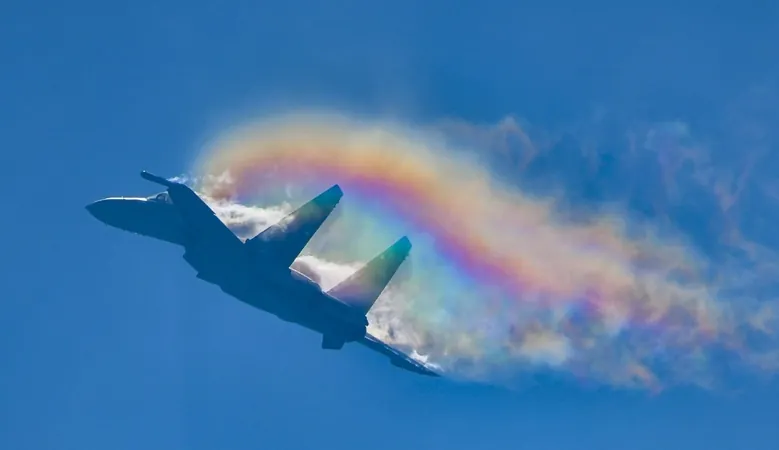
The New Battlefield: How 5G is Reshaping U.S.-China Aerial Warfare
2025-03-30
Author: Li
In March 2025, at the renowned Mobile World Congress (MWC) in Barcelona, Nokia unveiled a game-changing development in military communication technology. Lockheed Martin, the American defense and aerospace giant, had integrated Nokia’s military-grade 5G solutions into its Hybrid Base Station (HBS), a transformative network intended to enhance the resilience and security of military communications across air, land, and sea.
Lockheed's HBS is designed to ensure seamless data flow and dependable connectivity, critical for modern warfare. As tensions rise between global superpowers, the significance of integrating commercial 5G technology with military systems cannot be understated. This step towards interoperability promises to provide a vital edge in national defense strategies.
On the other side of the Pacific, China claims it has achieved a milestone of its own by introducing the world's first mobile 5G base station specifically designed for military use. Developed in cooperation with the China Mobile Communications Group and the People's Liberation Army (PLA), this cutting-edge base station reportedly supports up to 10,000 users within a radius of three kilometers, ensuring high-speed and low-latency data services. The system's potential to support an array of intelligent machines marks a pivotal moment in military capabilities.
As both nations invest heavily in advanced unmanned systems—including drones and robots that could dwarf human forces—the evolving landscape of aerial warfare is set for a dramatic shift. Effective communication remains crucial in military operations, where every seconds counts. With capabilities like instant data sharing and enhanced real-time insights, 5G technology is poised to revolutionize aerial combat.
Understanding the Game-Changing 5G Technology
The fifth generation of wireless communication, or 5G, is a leap forward from its predecessors, boasting ultra-fast data speeds, low latency, and unparalleled connectivity. Military aviation stands to benefit immensely from 5G, where every moment can mean the difference between victory and defeat. Unlike 4G, which struggles with lag, 5G can substantially reduce latency, enabling near-instantaneous communications essential for real-time operations.
5G technology operates on higher frequency bands, utilizing methods such as beam forming to focus signals on specific devices, optimizing communication strength, and minimizing interference. This leap in technology translates to robust data sharing in military aviation environments. Imagine fighter jets sharing crucial information such as target coordinates with ground units within milliseconds, enhancing coordination and operational efficiency.
Possibilities and Risks in Military Aviation
5G's incredible speed and data-handling capabilities facilitate real-time sharing of diverse types of information critical for military success—from telemetry data on aircraft performance to live video feeds from UAVs. Drones equipped with 5G technology can conduct missions autonomously while transmitting high-resolution data back to command centers, creating a more dynamic battlefield approach.
However, this rapid technological advancement comes with significant security risks. Military reliance on wireless technologies introduces vulnerability to cyberattacks, jamming, and espionage. Adversaries adept at electronic warfare can disrupt crucial communications, while a compromised network could result in disastrous operational failures. The concerns extend to supply chain dependencies, which might expose militaries to external surveillance and manipulation.
Mitigating Security Risks and Enhancing Command and Control
To address these challenges, military organizations must implement robust defense systems. Encrypting communications, employing multi-factor authentication, and establishing rigorous intrusion detection measures are crucial tactics. Additionally, having redundancy for communication networks ensures commanders maintain control during critical situations. This could involve satellite communications working alongside 5G networks to guarantee constant connectivity.
Moreover, integrating artificial intelligence with 5G networks can empower military forces to make informed, swift decisions based on real-time data analysis, further enhancing situational awareness. AI capabilities can analyze enemy movements and predict potential threats, revolutionizing military strategy and response.
As the competition intensifies between the U.S. and China over technological supremacy, alliances and geopolitical landscapes will likely shift significantly. The implications of harnessing 5G technology extend far beyond the battlefield; they will shape military doctrine, international relations, and the future of digital warfare itself.
Conclusion: The Future of Warfare is Here
As China and the U.S. engage in this technological race, the stakes could not be higher. Whoever masters 5G technology for military purposes may gain a critical advantage in aerial combat, further influencing global alliances, trade relations, and warfare tactics. The intersection of advanced wireless communications and military operations heralds a new era of conflict, where precision, speed, and data supremacy decide the fate of nations. The battle for 5G is about more than speed; it’s about control and power in a rapidly changing world.





 Brasil (PT)
Brasil (PT)
 Canada (EN)
Canada (EN)
 Chile (ES)
Chile (ES)
 Česko (CS)
Česko (CS)
 대한민국 (KO)
대한민국 (KO)
 España (ES)
España (ES)
 France (FR)
France (FR)
 Hong Kong (EN)
Hong Kong (EN)
 Italia (IT)
Italia (IT)
 日本 (JA)
日本 (JA)
 Magyarország (HU)
Magyarország (HU)
 Norge (NO)
Norge (NO)
 Polska (PL)
Polska (PL)
 Schweiz (DE)
Schweiz (DE)
 Singapore (EN)
Singapore (EN)
 Sverige (SV)
Sverige (SV)
 Suomi (FI)
Suomi (FI)
 Türkiye (TR)
Türkiye (TR)
 الإمارات العربية المتحدة (AR)
الإمارات العربية المتحدة (AR)